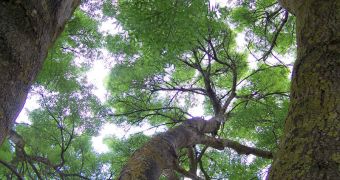Woodlands are ecosystems that operate in mysterious ways. Even so, Czech scientists succeeded in finding out how trees in dense forests cope with a decreased level of sunlight absorption and how their mechanism of capturing carbon for photosynthesis turns out to be effective in these conditions.
Their discovery is highlighted by the British Ecological Society's Functional Ecology. Apparently, experts are now able to explain the effects cloud cover has upon photosynthesis. It is already known that plants absorb carbon and rely on sunlight to produce oxygen.
In some of the cases, the sun rays reach the land without any interference, but in some cases it is diffused by various factors, including clouds, that can become as important as the sun is throughout the entire process, according to Science Daily.
Cloud covers manipulate temperatures and light, therefore experts say this element's presence is essential in the process of photosynthesis.
So far, scientists established that, far from being a bump in the road, the cloud cover is actually beneficial, since it can trigger a more efficient process of absorbing carbon from the atmosphere. At this point in time, the exact mechanism behind this phenomenon remains a mystery.
Despite the fact that the equation is still far from being solved, scientists involved in this project say that growing rates for photosynthesis could be explained through cloud covers' potential of distributing light in an equal manner to the tree leaves.
In order to test this rather controversial theory, experts analyzed the way ecosystems react during sunny and cloudy days.
Surprisingly, during the cloudy days forests managed to absorb more carbon, highlighting the beneficial role of the cloud cover. However, during a sunny day, experts say the top of the canopy manages to capture up to 78% of the total amount of carbon absorbed, while during cloudy days the percentage is reduced to only 43%.
After analyzing these results, scientists are now able to explain how the cloud covers influence the trees' photosynthesis. The vegetation adapts its entire process to the amount of light it receives and exploits the current conditions to preserve a high absorption of carbon, even in the cases when scientists expected to deal with lower photosynthesis rates.
“The ability of forests to not only adapt to the levels of light they regularly receive, but make effective use of those conditions, helps us to understand how individual trees can maintain such a high intake of carbon despite being overshadowed by the tops of the canopy,” declared Dr. Otmar Urban, from the Global Change Research Centre in Brno, Czech Republic, the leading author of this study.

 14 DAY TRIAL //
14 DAY TRIAL //